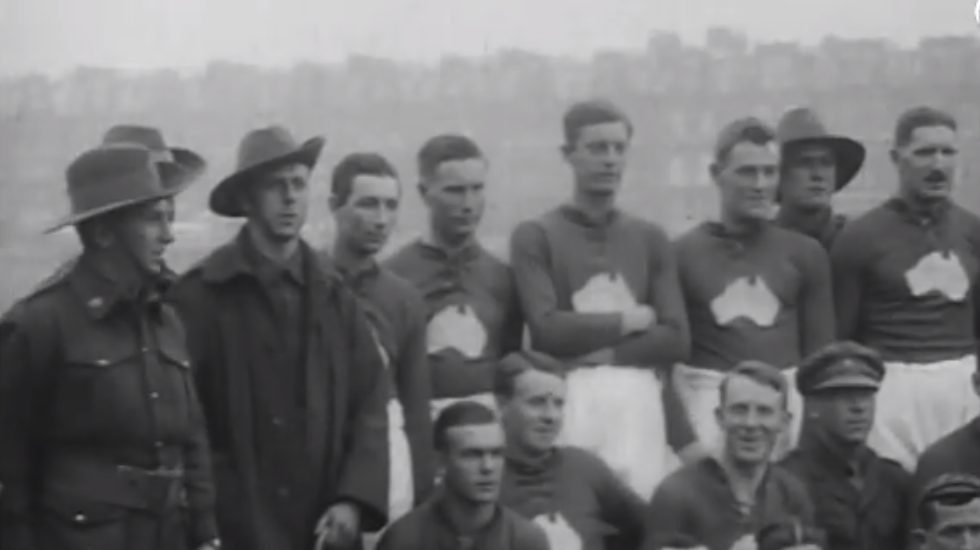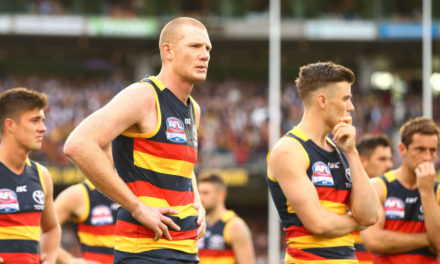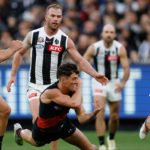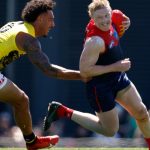The Third Australian Divisional team assembles for a photo before the exhibition game in London during the First World War.
Sunday’s clash between Geelong and West Coast marked the end of an unprecedented run of 10 days of AFL football in an 11-day period.
Whilst it was manna from heaven for insatiable footy fans such as you, me and anyone who has the first idea about sport, I fear it may have unintentionally diluted the ANZAC message this year.
The AFL did its bit, once again ensuring that each match played in round six paid due deference to what is now Australia’s most solemn and important annual day.
Sadly though, when the showpiece game between Collingwood and Essendon is remembered not for being a display of what we do with the freedoms for which so many Australian paid the ultimate sacrifice, but rather made notable because of an inane and seemingly endless debate over booing, then the message truly has been lost.
I am hopeful that the short piece that follows will in some small way address the aforementioned imbalance, and for the reader illustrate how our national game and serving Australia on the battlefield have gone hand-in-hand for over a century.
The War Can Wait – Let’s Play Footy!
In the midst of a war that would claim the lives of more Australians than all other wars combined, our Diggers found time to play a game of Australian Rules football that would be watched by royalty, military chiefs, Aussie Diggers and thousands of bemused Brits.
The brainchild of Olympic champion swimmer and military officer Lieutenant Frank Beaurepaire, a game of Australian football promoted as the “Pioneer Exhibition Game” was played in London on Saturday 28 October, 1916.
A team representing the Australian Training Units was pitted against a side from the Third Australian Division.
Both units were informed of the game only a week or so before it was scheduled to be held, with any individual interested in participating requested to attending a training session.
There is no record of what the organisers were expecting in terms of player quality, but what they got was enough players from the VFL, VFA, SANFL and WAFL to field two sides that could have held their own in any of those competitions.
With all funds raised going to the British and French Red Cross, the game was advertised widely in London’s newspapers. Sports writers contended that the Australian game sat somewhere between soccer and rugby with rules that were clearly designed to ensure a fast paced, high-scoring sport.
Curious Londoners joined a throng of Australian servicemen and women at the Queen’s Club in West Kensington to watch the match. Also in attendance was Edward, Prince of Wales and future King of England, along with King Manuel II of Portugal.
Decked out in a red guernsey with a white kangaroo over the left breast, the Australian Training Unit team was skippered by Norwood man Charlie Perry, with Fitzroy’s Jack Cooper named as his deputy. The side was made up of footballers from around Australia with VFL players making up about half the side.
The Third Australian Divisional team also took the field in guernseys that were made in England and as unmistakably Australian as their opponents.
Their colours of dark blue with a centrally positioned white map of Australia contrasted perfectly with the red of the Training Unit team whilst also tapping into the battle in English Association football between the reds and the blues, which was as earnest in 1916 as it is today.
The red side was predominately made up of Victorian footballers, with the exceptions being two men from the WAFL, Jim Foy of East Perth and Perth’s Cyril Holt. The captain was Bruce Sloss of South Melbourne, with legendary footballer and future VFL premiership coach Dan Minogue installed as vie captain.
The game commenced at precisely 3pm, with a strong wind making it difficult to execute the skills synonymous with the game. Nevertheless the quality of players on both sides ensured a match filled with spectacular high marks and pinpoint kicking. The crowd found the spectacle thrilling, “oohing and aahing” constantly throughout the match.
After three quarters of evenly contested Australian football, the lads form the Third Divisional Unit took control in the final stanza going on to record a 16-point victory, 6.16 (52) to 4.12 (36).
Carl Wills of University and Harold Moyes of St. Kilda each kicked a brace for the winners, whilst for the beaten Training Unit the four goals were evenly spread.
The Times of London was one of many publications to report on the match, providing a revealing insight into what the public made of a game they had never seen previously.
The Times report gave painstaking details of the size of the oval as well as a brief rundown of the rules of the game, including the fact it was played over four 20 minute quarters. It was noted that there was no off-side rule and that the game was designed to ensure the ball moved over long distances at pace.
The reporter was taken by Australian barracking, describing it as “a cheerful running commentary, on the players, fellow spectators, the referee, the line umpires and lastly the game itself”.
The dry Australian wit that our fighting men were famous for also caught the attention of the Times man He picked up on a line from one of the Diggers keenly watching the game, reporting it thus: “When a catch was missed, a shrill and penetrating voice inquired of the abashed player, ‘Do you think it’s a bomb mate? It’s not you know, it’s the ball’.”
In all, the report was glowing in its praise of a skilful sport, which whilst physical and not for the faint-hearted, was played in fine spirits by those involved.
The game was a roaring success, raising much-needed funds for a cause vital to the war effort, lifting spirits amongst Australian military personnel and showcasing Australian Rules football professionally and with star players to the rest of the world for the first time.
Sadly, that Saturday in late October was atypical of the Australian experience in The Great War.
The reality was that pride in their newly-formed nation combined with a spirit of adventure and mateship drove a generation of naïve young Australians from the relative safety of their lives down under into a war that was as brutal as it was ravenous.
They went willingly into a madness where tens of thousands of men would be routinely sacrificed in order to gain less ground than you could cover with a mongrel drop punt.
The Great War consumed souls at an ever increasing rate. No-one was safe from its clutches, not even champion footballers.
As soon as the bell rang to signal the end of the Pioneer Exhibition Game, those spectacular red and blue jumpers came off. Defenders, ruckmen, wingmen and sharp-shooting forwards got back into their army clobber and within days shipped out to join their mates at various fronts.
By June of 1917, three men who played in that famous game of football had made the ultimate sacrifice.
Stanley Carlton Martin played for the Training Units side, and whilst there are no records of how he performed during the match, we do know he was one heck of a footballer.
The Wesley student was a stand-out at school sports and prior to entering the dental faculty at Melbourne University in 1910 was courted by a number of VFL clubs.
In spite of his middle name, he chose to play for University, which had been admitted into the VFL two years earlier. Martin went on to be one of that club’s finest ever players, participating in 65 matches before enlisting in the First AIF in 1915.
Renowned footballer reporter Gerald Brosnan said of Martin that he was one of the finest exponents of the running drop kick he had ever seen. Quick and skilful, it’s no surprise that Stan Martin played nearly all of his VFL football as a winger.
Martin served as a bayonet instructor, a role which did not preclude him from seeing live action. He was killed in battle on May 3, 1917, in Bullecourt, France.
Private Les Lee played on the winning side in the London game, and if the legendary Dan Minogue is to be believed, then Lee was best on ground that day.
Minogue described Lee as an unknown player, but said he was the hero of the game. Lee played in the first ruck and kicked one of six goals for the AIF that day. Minogue went on to say that had Lee survived the war, Richmond would have had another Jack Dyer on its hands.
Leslie Edward Lee is thought to have died at Snitchell’s Farm in Messines, Belgium on June 8, 1917. Though his body was never found, a report from members of his battalion suggest Lee was hit by a shell whilst firing from a trench.
He suffered serious injuries to his upper body. His fellow diggers tried to move him to receive medical attention, but were unable to do so. It was said that the bulky frame that served him so well on the football field was sadly his undoing.
Upon hearing of his passing, Lee’s family wrote a moving tribute for The Richmond News. ‘Leggo’, as he was known to his mates, was a local lad much loved by teammates at a number of clubs.
Born in Adelaide, he settled in Richmond as a lad and played locally till spotted by VFL side Richmond in 1913. He played only two games before returning to play locally, but it is thought he planned to play in the VFL after serving in the AIF.
Sadly Lee never got that chance.
The third player from that famous exhibition game to pass was one of football’s early champions.
Bruce Moses Farquhar Sloss had a modest introduction to VFL football, playing just three games for Essendon in 1906, before club and player seemingly lost interest in each other.
He would not play his next VFL game until midway through the 1910 season. When he re-emerged, this time as a ruckman for South Melbourne, he was an imposing figure, having honed his skill and built up his body whilst playing for Brighton in the VFA.
Sloss was now a star. He was best on ground on debut for the Bloods, and led them into the finals in 1910 with a number of successive best on ground performances.
It was no surprise then in 1911, that when able to play a full season Sloss was named Champion of the Colony, the early equivalent of the Brownlow Medal. Sloss played and starred in two losing Grand Finals for South Melbourne, so it was little wonder he was named captain of that famous AIF team that went on to win in London.
The 1914 grand final was Bruce Sloss’ final VFL match. Fiercely patriotic, he joined the 10th Machine Gun Regiment in 1915, with the aim of following three older brothers to Europe. He fulfilled that goal in 1916 and whilst the three older Sloss brothers survived being wounded to all return to Australia, tragically, Bruce made the ultimate sacrifice and never returned.
On January 4, 1917, he was positioned two miles behind the front lines in Armentieres, France. Lieutenant Sloss would not have thought he was in imminent danger whilst returning from a walk. He was inside the gates, when a fellow officer called him and he walked back to talk to him.
Some minutes later, he was walking through those same gates when an errant German shell that overshot its intended target by some distance landed and exploded at his feet. Had he not doubled back for a chat or had the German shell landed anywhere near its intended target, Sloss may well have made it home with his three brothers. Sadly, he found himself in the wrong place at the wrong time and was killed instantly.
It was no surprise that his distraught army mates found a neatly folded Australian flag on his person. Sloss was proudly Australian, and whilst he may have been a champion footballer, it was said of him he would have wished to be remembered as simply Bruce Sloss, Australian Army.
There are countless stories of football and the armed services, and becoming familiar with at least one seems a worthy way to mark ANZAC day each year as a footy fan.
Sorry to Gerard, Eddie, Bruce and all the journos who used their precious time on air on Anzac Day to dissect the booing, because if you don’t spend time on April 25 each year to reflect and show your gratitude, I might just have to boo you.
*Footnote – There is wonderful footage from the Pioneer Exhibition Game accessible on YouTube RIGHT HERE.











